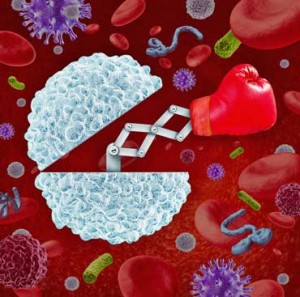



Researchers have quickly jumped on the small nerve fiber neuropathy (SFN) finding in Fibromyalgia. After starting out with smaller studies some bigger ones are starting to show up, and the outlines of SFN prevalence in FM are beginning to emerge.

The authors believe the immune system is probably the culprit – but no direct evidence of that exists yet
This Greek study was not particularly big – 46 FM patients – but it was a step in the right direction. It also included a significant subset (30%) of FM patients with autoimmune disorders in its cohort. They noted that SFN is the most common type of neuropathy in Sjogren’s Syndrome, a female-dominated autoimmune disorder (that may be underdiagnosed in ME/CFS and FM). As an added bonus they also examined Langerhorn cells and stained the skin biopsies for IL-6 in a small number of patients.
In the introduction the authors went straight to the immune system – cytokines and mast cells – as a possible cause for the increased rates of SFN found in Fibromyalgia.
Let’s see what they found.
Findings
Reduction of Intraepidermal Nerve Fiber Density (IENFD) in the skin biopsies of patients with fibromyalgia: A controlled study. Michalis L. Kosmidis, Loukia Koutsogeorgopoulou, Harry Alexopoulos, Ioanna Mamali, Panagiotis G. Vlachoyiannopoulos, Michalis Voulgarelis. Journal of the Neurological Sciences xxx (2014) xxx–xxx
The 35% of FM patients found to have significantly reduced nerve densities in their skin in this study was roughly in line with findings from other studies.
It’s not clear yet how how SFN contributes to the symptoms in FM. In some ways the two conditions don’t fit. SFN is a “length dependent process” that usually shows up as pain and/or other symptoms (tingling, numbness) at the ends of long nerves in the feet and hands. Pain and tingling in the feet can show up in Fibromyalgia, but FM is usually characterized by diffuse, not localized and deep, not surface, pain that is often worse in the upper body.
Indeed, the fact that pain intensity in this study was not correlated with reduced nerve fiber density suggests the SFN in FM may not be contributing to much of the pain seen in FM. On other hand, when pain is present in SFN it’s been associated with excessive firing of the remaining nerves – which has been found in FM. The upshot is that we just don’t know how small fiber neuropathy contributes to the pain in FM – we just know SFN is present.
It’s possible that the SFN in FM does extend to the upper body, but studies have not confirmed that. One researcher has suggested the nerve damage extends deeper into the body in FM, but we don’t know that either. There’s still much to learn about where and how often SFN is found in FM.
SFN Prevalence in Fibromyalgia Underestimated?
The authors suggested that the 30-40% of FM patients indicated as having SFN in the studies thus far is probably a low ball figure. The limited testing done so far – done at one or two points in the body – probably misses, they suggested, many FM patients with SFN in other parts of the body. No studies, for instance, have yet examined nerve fiber density at the well-defined “tender spots” in FM patients. SFN in other disorders is usually found at the ends of the longest nerves in the body but it’s not clear, as well, if it’s limited to the extremities in FM. Hopefully the next set of SFN studies will examine nerve density in the FM tender points and the upper body.
Not Getting at the Cause… Yet
Determining the cause of the SFN found, is of course, critical. The authors of this study proposed that an autoimmune process that attacked not the small nerve fibers in the skin but the small ganglionic neurons they’re connected to was a likely candidate. They pointed to the high rate of FM patients with autoimmune disorders (30%) in this study, and noted that some FM patients significantly improve on IVIG. [In another Health Rising blog Dr. Siveri noted that FM is a complex condition that requires multiple points of attack and that IVIG alone is not likely to be the answer.]
Neither these authors’ brief look at immune functioning (Langerhorn cells, IL-6 staining) in a small number of patients nor a recent study found evidence of immune alterations in the skin in FM. If it’s not the immune system then neuroinflammatory factors that cause neuronal degeneration could be at work.
Who wants to bet that something completely unexpected and possibly novel is at work? Disorders like FM and ME/CFS have not given up their secrets easily.
Psychological Slant Takes a Hit With Small Nerve Fiber Findings
“These patients are often labeled as having a psychiatric disease, even though they do not fit into a true primary psychiatric disorder, nor do they have history of stressful or depressive events preceding the onset of their painful syndromes.”
The authors’ last words reflect a belief that recent findings are breaking up the default conversation that both FM and ME/CFS are psychiatric disorders. [Similar comments were recently made by Stanford researchers regarding their recent brain findings in ME/CFS.] They also bring to mind a psychiatrist’s recent study on the efficacy of antiviral therapy in adolescents with ME/CFS. Many of the adolescents had been diagnosed with treatment-resistant depression despite the fact they did not meet the criteria for depression (!).

Negative default conversations continue to characterize many practitioners approach to FM and ME/CFS.
I had a similar experience 25 years ago. I had a very smart doctor who surely knew the criteria for depression, but who sent me to a psychologist who quickly realized that I didn’t have any symptoms of depression. I’ll never forget the undertones of anger in that doctor’s voice as he sent me on my way. Never mind that I clearly wasn’t depressed; this doctor’s default response to cases like mine that confused him was to get angry and then send me to a psychologist. He probably did that dozens of times during his medical career.
This mindset has pervaded parts of the medical profession as long as poorly-defined disorders have been around. A medical establishment able to conclude or even speculate at one point that the crippling effects of multiple sclerosis reflected a mental derangement could easily conclude today that disorders like FM and ME/CFS are mental. Medical tests are more sophisticated now, but the human mind is not.
Conclusions
The authors noted the “notoriously negative laboratory workups” FM patients are known for. The accumulating evidence that SFN is present in FM suggests those negative laboratory workups may be a thing of the past for many. Skin biopsies for SFN are easy to do, are not particularly expensive and, with Therapath validating another testing spot on the body, are more comprehensive than before.
The findings are still, however, being ignored by some major figures in FM. In a recent WebMD article on “The Latest in FM Diagnosis and Care” Dr. Clauw – an advocate of the role central sensitization plays in FM – failed to mention the SFN findings.
Large-scale studies are needed now to determine how common SFN is in FM, why it’s present, and how it’s affecting the symptoms that patients experience. The continuing flow of SFN studies indicates that the research community is jumping on SFN findings this time.








Past few months, have developed marked swelling, burning and itching in my feet.
Started with just redness and burning without swelling. Has progressed to plus 2 indentation by finger pressing.
Scheduled for EMG this month.
You might remind your doctors about chronic regional pain syndrome (CRPS). Good luck!
Would be interested to know who is showing up with positive SFPN symptoms – age of onset, length of illness etc. After 23 years of FM I had no symptoms that looked like SFPN and then five years ago – BAM – new symptoms. Curious to know if this would be result of poor glucose metabolism (not diabetic) related to poor metabolic function.
Time will tell I guess 🙂
Hi Chris,
I started experiencing SFN symptoms five years ago at age 53 — 20 years after being diagnosed with ME/FM/MCS. A few months after the numbness and burning/tingling/stinging pain in my hands and feet started, I awoke one morning with joints so stiff and painful, I could barely get out of bed. I was later diagnosed with rheumatoid arthritis, and for a while attributed the neuropathic pain to this autoimmune illness. However, both my GP and Rheumatologist disagree. Because, it seems medication is keeping the RA under control. For now, I’m attributing my SFN symptoms to worsening FM as I age.
I can’t comment on whether or not poor glucose metabolism could result in SFN symptoms. But, based on my experience, new symptoms can most certainly start long after the onset of an illness.
Hi Chris, My symptoms started a few months at most after I became chronically ill at the age of 40.
I sure hope you’re right about them jumping on SFN. I’ve often said I could handle the rest of the pain if I didn’t have SFN, too.
I’ve not had a skin biopsy, but I know the symptoms all too well. The pins & needles progressed to a constant severe burning/cold painful to the touch disorder. (A bed sheet resting on my foot can wake me up from deep sleep.) At times it feels like hundreds of bees stinging my calves.
What I’d give for a treatment I could tolerate. For instance, Lyrica provided much relief but changed my mood drastically and not for the better. Is my researching IVIG therapy worth pursuing? Sixteen years has made me jaded, and I’ve pretty much given up on treatments for SFN at this time.
Thank you so much for your articals Cort. I’m much more able to comprehend them than I am the lengthy medical journals, etc.
Ouch….that sounds really painful. I know IVIG helps some people – what percentage I have no idea. Hopefully they’ll keep digging into SFN in FM and we’ll get some answers about causes…Good luck!
I tried IV I G 10 years ago. Went in the hospital for five days in a row for treatment, and it did absolutely nothing for SFN.
It was recently discovered by the Stanford team that the chronic inflammation associated with CFS/ME results in a shrinkage of the white matter connectivity tissue in the brain, so wouldn’t it stand to reason that a chronic inflammation of nerve fibers in FM would cause some shrinkage in those fibers? Perhaps the pain is a result of the inflammation from, say, a virus, and the neuropathy is the result.
Definitely could be. They didn’t find evidence of increased cytokines in the skin but the search for immune factors that are “roasting” the nerves in the skin is not over 🙂
I get you periodic emails and thought it was offering more pills offering help. How many out there would gladly give up on this type of anniversity. 17 years with FM and CFS. It has taken thebest years of my life and continues to attack adding pain to pain. How can I be a part ofthe research being done here?